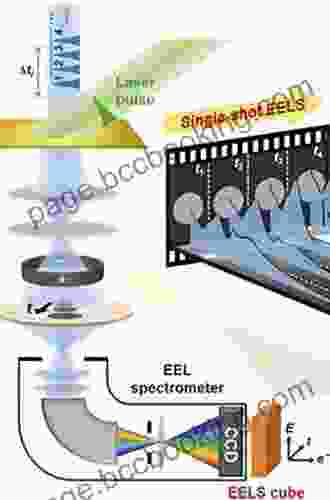Electron Energy Loss Spectroscopy In The Electron Microscope: Unlocking the Secrets of Materials

Electron energy loss spectroscopy (EELS) is a powerful analytical technique that provides detailed information about the electronic structure and chemical composition of materials. It is widely used in transmission electron microscopy (TEM) to study a variety of materials, including metals, semiconductors, polymers, and biological samples.
EELS works by measuring the energy loss of electrons that have passed through a thin specimen. The energy loss is characteristic of the material's electronic structure and chemical composition. By analyzing the energy loss spectrum, it is possible to identify the elements present in the specimen, determine their chemical bonding, and measure the thickness of the specimen.
EELS is a versatile technique that can be used to study a wide range of materials and problems. It is particularly well-suited for studying materials at the nanoscale, where other techniques may be limited.
4.7 out of 5
| Language | : | English |
| File size | : | 18472 KB |
| Text-to-Speech | : | Enabled |
| Screen Reader | : | Supported |
| Enhanced typesetting | : | Enabled |
| Print length | : | 1102 pages |
EELS works by measuring the energy loss of electrons that have passed through a thin specimen. The energy loss is characteristic of the material's electronic structure and chemical composition.
When an electron passes through a material, it can interact with the electrons in the material's atoms. These interactions can cause the electron to lose energy. The amount of energy lost is characteristic of the type of interaction that occurred.
There are two main types of interactions that can occur between an electron and an atom: elastic scattering and inelastic scattering. In elastic scattering, the electron does not lose any energy. In inelastic scattering, the electron loses energy.
The energy loss spectrum is a plot of the number of electrons that have lost a given amount of energy. The energy loss spectrum can be used to identify the elements present in the specimen, determine their chemical bonding, and measure the thickness of the specimen.
EELS has a number of advantages over other analytical techniques. These advantages include:
- High spatial resolution: EELS can be used to study materials at the nanoscale. This makes it ideal for studying materials that are too small for other techniques to analyze.
- Chemical sensitivity: EELS can identify the elements present in a specimen and determine their chemical bonding. This information can be used to understand the structure and properties of the material.
- Quantitative analysis: EELS can be used to measure the thickness of a specimen and the concentration of elements in a specimen. This information can be used to characterize the material and to understand its properties.
EELS is used in a wide variety of applications, including:
- Materials science: EELS is used to study the electronic structure and chemical composition of materials. This information can be used to understand the properties of materials and to develop new materials with improved properties.
- Nanoscience: EELS is used to study materials at the nanoscale. This information can be used to understand the properties of nanomaterials and to develop new nanomaterials with improved properties.
- Biological science: EELS is used to study the structure and function of biological molecules. This information can be used to understand the mechanisms of biological processes and to develop new drugs and therapies.
EELS is a powerful analytical technique that provides detailed information about the electronic structure and chemical composition of materials. It is widely used in TEM to study a variety of materials, including metals, semiconductors, polymers, and biological samples. EELS is a versatile technique that can be used to study a wide range of materials and problems. It is particularly well-suited for studying materials at the nanoscale, where other techniques may be limited.
4.7 out of 5
| Language | : | English |
| File size | : | 18472 KB |
| Text-to-Speech | : | Enabled |
| Screen Reader | : | Supported |
| Enhanced typesetting | : | Enabled |
| Print length | : | 1102 pages |
Do you want to contribute by writing guest posts on this blog?
Please contact us and send us a resume of previous articles that you have written.
 Book
Book Novel
Novel Page
Page Chapter
Chapter Text
Text Story
Story Genre
Genre Reader
Reader Library
Library Paperback
Paperback E-book
E-book Magazine
Magazine Newspaper
Newspaper Paragraph
Paragraph Sentence
Sentence Bookmark
Bookmark Shelf
Shelf Glossary
Glossary Bibliography
Bibliography Foreword
Foreword Preface
Preface Synopsis
Synopsis Annotation
Annotation Footnote
Footnote Manuscript
Manuscript Scroll
Scroll Codex
Codex Tome
Tome Bestseller
Bestseller Classics
Classics Library card
Library card Narrative
Narrative Biography
Biography Autobiography
Autobiography Memoir
Memoir Reference
Reference Encyclopedia
Encyclopedia Shahan Mufti
Shahan Mufti Oscar Serrallach
Oscar Serrallach Paul Mccarthy
Paul Mccarthy Ofer Gal
Ofer Gal Wendy Mogel
Wendy Mogel Peter Mayle
Peter Mayle Peter Montiel
Peter Montiel Steven T Callan
Steven T Callan Peter Darman
Peter Darman Rachel Mcmillan
Rachel Mcmillan Peter Ustinov
Peter Ustinov Pat Shipman
Pat Shipman Twaambo Kapilikisha
Twaambo Kapilikisha Steve Robert Kendall
Steve Robert Kendall Tom Robbins
Tom Robbins O Neil De Noux
O Neil De Noux Matt Christopher
Matt Christopher Pinky Mckay
Pinky Mckay Rory Sutherland
Rory Sutherland Patrick Stewart
Patrick Stewart
Light bulbAdvertise smarter! Our strategic ad space ensures maximum exposure. Reserve your spot today!
 David Foster WallaceFollow ·15.1k
David Foster WallaceFollow ·15.1k Elmer PowellFollow ·3.4k
Elmer PowellFollow ·3.4k Aleksandr PushkinFollow ·10.1k
Aleksandr PushkinFollow ·10.1k Ken FollettFollow ·7.7k
Ken FollettFollow ·7.7k Duncan CoxFollow ·10.7k
Duncan CoxFollow ·10.7k Milton BellFollow ·3.2k
Milton BellFollow ·3.2k Norman ButlerFollow ·5.5k
Norman ButlerFollow ·5.5k Jamal BlairFollow ·4.4k
Jamal BlairFollow ·4.4k

 Marvin Hayes
Marvin HayesGoverning Law for Law School and Bar Exam Prep: Your...
Unlock the Secrets of...

 Sidney Cox
Sidney CoxUnveiling the Epic Tales of Whiskey, War, and Military...
In the tapestry of history,...

 Victor Turner
Victor TurnerGoverning Law for Law School and Bar Exam Prep: The...
What is Governing...

 Robert Browning
Robert BrowningSterling Test Prep MCAT General Chemistry Practice...
: Embark on Your MCAT General Chemistry...
4.7 out of 5
| Language | : | English |
| File size | : | 18472 KB |
| Text-to-Speech | : | Enabled |
| Screen Reader | : | Supported |
| Enhanced typesetting | : | Enabled |
| Print length | : | 1102 pages |















